Wang, X., Kukulka, T., Plueddemann, A., 2022. Wind fetch and direction effects on Langmuir turbulence in a coastal ocean. Journal of Geophysical Research: Oceans, 127, e2021JC018222. https://doi.org/10.1029/2021jc018222

Figure provided by Al Plueddemann
The strength of Langmuir turbulence in the upper ocean can be assessed by the root mean square of the convergence velocity, VRMS, at the sea surface. Langmuir turbulence is expected to be dominant when the Langmuir number, Lat = sqrt(U*/Us) is < 1, where U* is the friction velocity of the wind and Us is the Stokes drift at the surface (calculated from wave height spectra). When wind and waves are misaligned by an angle theta, only the Stokes drift in the direction of the wind is relevant, as measured by the “projected” Langmuir number Lat = sqrt(U*/Us cos(theta)).
Recent work by Wang et al. (2022) shows that near the coast, fetch limitations can lead to significant misalignment of wind and Stokes drift for some wind directions. Both observation and numerical model results demonstrate that the misalignment reduces the strength of Langmuir turbulence. The study was unique in jointly analyzing observations and LES modeling for a variety of forcing conditions.
The figure shows the observed probability distributions of (a) VRMS, (b) wind speed, and (c) Lat < 0.7 as a function of wind direction during the CBLAST-low experiment. The lengths of the color bars represent the proportion of occurrence in the direction range. In panel (c), the gray and green bars represent the percentage occurrence of Lat < 0.7 and projected Lat < 0.7, respectively. Langmuir turbulence as measured by VRMS (panel a) is found to be weaker for similar wind speed (panel b) for misaligned conditions – winds blowing from 40° to 110° and 290° to 330° where projected Lat < 0.7 is significantly less likely than Lat < 0.7 (panel c).
